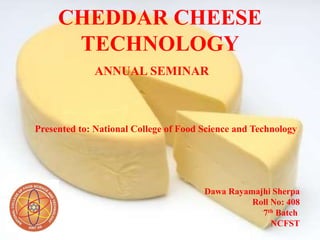
Cheese Technology
- 1. CHEDDAR CHEESE TECHNOLOGY Dawa Rayamajhi Sherpa Roll No: 408 7th Batch NCFST Presented to: National College of Food Science and Technology ANNUAL SEMINAR
- 2. CONTENTS 1. Introduction 2. Types of cheese 3. Technology of Cheddar cheese production 4. General flow diagram of cheddar cheese production 5. Factors affecting cheese quality 6. Milk Additives 7. Cheese scenario in Nepal 8. Conclusion
- 3. • The word cheese comes from Latin word “caseus” • Earliest proposed dates for the origin of cheese making range from around 8000 BC 1. INTRODUCTION
- 4. • Definition acc/ WHO Cheese is fresh or mature solid or semi-solid product obtained by coagulating milk, skim-milk, partially skim-milk, cream, butter- milk or any combination of these materials, through the action of rennet or other suitable coagulating agents, and by draining the whey resulting from such coagulation
- 5. • Cheddar cheese is a relatively hard, off-white (or orange if spices such as annatto are added), sometimes sharp-tasting (i.e., bitter), natural cheese. Originating in the British village of Cheddar in Somerset
- 6. 1.1 OBJECTIVE • Primary Objective -to study about cheddar cheese technology • Secondary Objective -to introduce cheese -to study the technology of cheddar cheese production -to study the factors affecting the cheese quality
- 7. 2. TYPES OF CHEESE • There are many types of cheese, with around 500 different varieties recognized by the International Dairy Federation • The varieties may be grouped or classified into types according to criteria such as length of ageing, texture, methods of making, fat content, animal milk, country or region of origin, etc,
- 8. Examples… • Extra hard cheese: Parmesan, Goya, etc • Hard cheese: Cheddar, etc • Semi-hard cheese: Gouda, Samsoe, Fontal, etc • Semi-soft cheese: Tilsit, Danbo, Butterkäse, etc • Soft cheese: Port Salut, Feta, etc • Mould cheese: Blue veined cheese, Stilton, etc • White surface ripened cheese: Camembert, Brie etc • Fresh cheese/ Unripened cheese: Queso Fresco, Cottage Cheese etc
- 9. 3. TECHNOLOGY OF CHEESE PRODUCTION 3.1 PRINCIPLE OF CHEESE PROCESSING a. Curdling b. Curd Processing - stretching - cheddaring - washing c. Ripening
- 10. a. Curdling • It is separating the milk into solid curds and liquid whey • It is done by acidifying (souring) the milk and adding rennet • Most cheeses are made with starter bacteria from the Lactococcus, Lactobacillus or Streptococcus families. Swiss starter cultures also include Propionibacter shermani, which produces carbon dioxide gas bubbles during aging, giving Swiss cheese or Emmental its holes (called "eyes") • Fresh cheeses are curdled only by acidity, but most cheeses also use rennet • In general, softer, smaller, fresher cheeses are curdled with a greater proportion of acid to rennet than harder, larger, longer- aged varieties
- 11. b. Curd processing - cutting • Now a very moist gel i.e. curd is cut and allowed to exudates the excess whey. developing a stiff, solid body
- 12. - cheddaring • The cut curd is repeatedly piled up, pushing more moisture away. The curd is also mixed (or milled) for a long time, taking the sharp edges off the cut curd pieces and influencing the final product's texture.
- 13. - washing • The curd is washed in warm water, lowering its acidity and making for a milder-tasting cheese
- 14. c. Ripening • A newborn cheese is usually salty yet bland in flavor and, for harder varieties, rubbery in texture normally cheeses are left to rest under controlled conditions and this period is called ripening, or, from the French, (affinage) • Ripening lasts from a few days to several years • Some cheeses have additional bacteria or molds intentionally introduced before or during aging • As a cheese ages, microbes and enzymes transform texture and intensify flavor.
- 15. 4. GENERAL FLOW DIAGRAM OF CHEESE PRODUCTION
- 16. 5. FACTOR AFFECTING CHEESE QUALITY • Raw material quality i.e. Milk quality • Pasteurization • Homogenization for color • Pre-ripening for flavor development • Storage condition i.e. Time, Temperature, RH for texture and flavor • CCP for cheese production is pasteurization and inoculation of culture
- 17. 6. MILK ADDITIVES • Calcium chloride (5-20g/100kg milk) : It is used as source of calcium which helps in firm and stable curd • Salt Peter (30g/100kg milk) : acts as preservatives and inhibits the fault fermentation i.e. early bloom and late bloom • Culture (10^9-10^11 cfu/dose per 1000L) : For flavor and safe fermentation. Homofermentatives as Lactococcus lactis and heterofermentatives as Lactococcus diacetylactics • Rennet (1.5g/100L) : It is used for coagulation and curd formation by breaking the k-casein into para-k- casein and glycomacropeptide • Lysosymes: It is used as substitution of salt peter for it remains in curd and cheese where as nitrate from salt peter may be lost in whey
- 18. 7. CHEESE SCENARIO IN NEPAL • The production of cheese by factory started in 1953/54 at Lamjung • Nepal produced some 350 MT cheese in 2000 • Nepali Cheese are: Yak (Nak) Cheese, Kanchan (Cow) Cheese and Goat Cheese • Nepal also produce cheese as Mozzarella cheese, Processed cheese and Cheese spread
- 19. 8. CONCLUSION • General characteristics about cheese is studied and it is found that there is hundreds varieties of cheese • Cheese production technology is studied • Nepalese scenario of cheese is studied • Classification of cheese is studied • Factors affecting cheese quality is studied